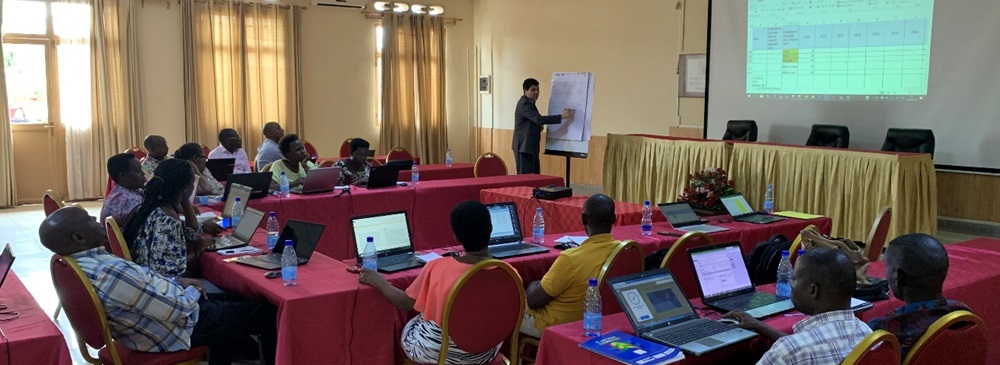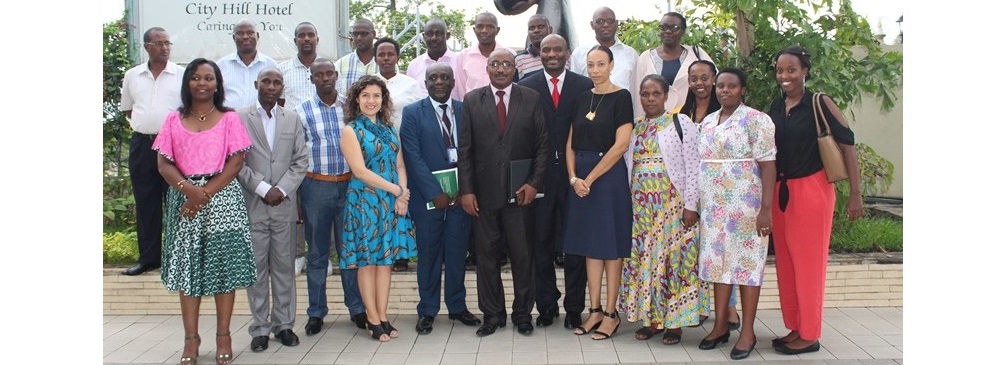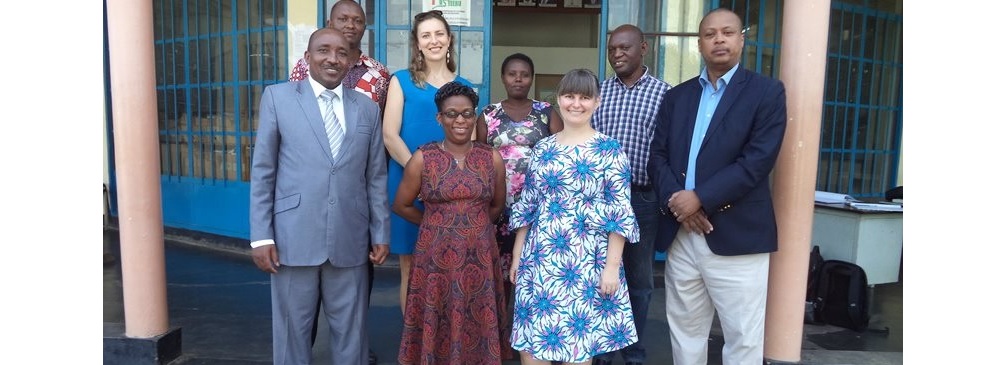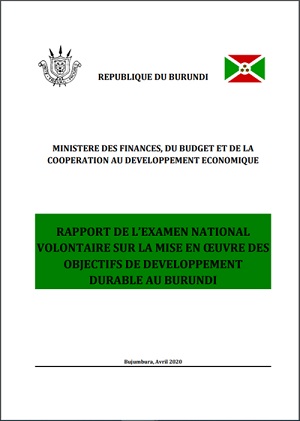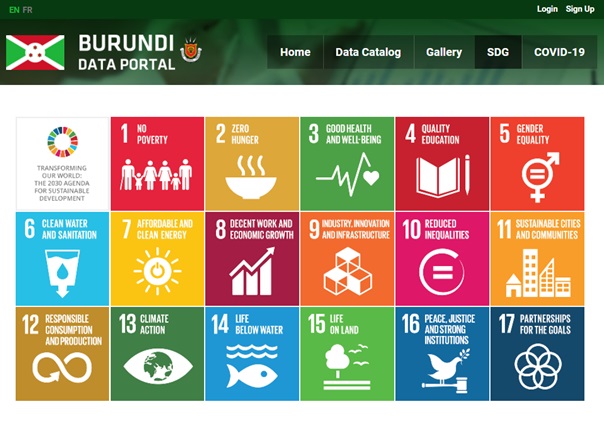Burundi
I. General on SDG monitoring set up
National SDG organizational set up
In Burundi, the SDG process is overseen by a multisectoral and multidisciplinary national commission of national experts for monitoring progress toward the SDGs. Between September 2017 and June 2020, it was under the supervision of the Second Vice-President of the Republic between. After the modification of the government structure of Burundi in June 2020, it came under the supervision of the Prime Minister.
National set of SDG indicators
In September 2018, the Ministry of Finance and the Burundi Institute of Statistics and Economic Studies (ISTEEBU), supported by UNDP, officially launched a report1 on mapping the SDG indicators and national priority indicators. The report defined the national indicator framework: 17 Goals, 111 targets and 176 priority indicators for Burundi (including 50 implementation indicators, as well as 25 partnership indicators under goal 17). It also presented an overview of data availability and sources, provided reference data points and highlighted remaining data gaps.
SDG report and Voluntary National Review
Burundi submitted its first VNR in 2020 and presented it at the High-level Political Forum on Sustainable Development in July 2020.https://burundi.opendataforafrica.org/addin/sdg
Burundi has selected the Open Data Platform (ODP) developed and supported by the African Development Bank as its national SDG reporting platform. A capacity building workshop was conducted by the African Development Bank and UNSD in February 2020 to train ISTEEBU and NSS staff on how to upload and modify data sets on the platform, how to create dashboards and visualizations, and how to administer data sharing via the platform. Currently, 123 national indicators have been uploaded with data and metadata to the Open Data Platform.
Overall coordination of National Statistical System
Coordination of the national statistical system of Burundi as a whole is carried out at the political level via the Comité National de l’Information Statistique (CNIS) (National Committee on Statistical Information), headed by the Second Vice President of the Republic of Burundi. Oversight over technical matters is the purview of the Comité Technique de l’Information Statistique (CTIS) (Technical Committee on Statistical Information), led by the Director General of ISTEEBU. ISTEEBU is under the supervision of the Ministry of Finance, Budget and Economic Planification.ISTEEBU is one of the members of the national statistical system of Burundi, which according to the statistical law of 2007, also includes: the National Council for Statistical Information, the entities responsible for developing statistical data placed within ministries, departments and agencies, and national schools and institutions for statistical and demographic training.
SDG data coordination committees
Coordination of the NSS around SDG monitoring is achieved in Burundi through the Comité multisectoriel de suivi des indicateurs de mise en oeuvre des ODD (Multisectoral Committee for Monitoring the SDG Implementation Indicators). Each Ministry, Department and Agency has an SDG focal point, in addition to the ISTEEBU SDG focal point. Data compilation is conducted by ISTEEBU. The most recent National Strategy for the Development of Statistics (NSDS) 2016-2020 incorporates the SDGs.
Responsibility for SDG indicator compilation
There is a specification that defines which agency is responsible for reporting on each indicator. If an indicator is validated, it is widely shared with relevant stakeholders upon request.
There is a solid base of statistical capacity and cooperation among the members of the Burundi NSS, despite financial and infrastructural challenges. There is ongoing collaboration and data and metadata sharing within the statistical system.
Actual data sharing mechanisms
Centralized compilation of data and metadata is done through the use of a collection templates that are sent to the focal point of each sectorial ministry. The focal point then gathers the informatio in their sector to complete the templateand return it to ISTEEBU for compilation.
IV. Data availability and disaggregation
Work to make more indicators available
ISTEEBU has put together a detailed spreadsheet of available data for SDG indicators covering years 2010-2017, including available disaggregations. A significant portion of the indicators derive from the Enquête sur les conditions de vie des ménages burundais (ECVMB) 2013-2014, Burundi’s most recent household living conditions survey, and the Enquête Démographique et de Santé au Burundi (EDSB-III) 2016-2017, Burundi’s DHS. ISTEEBU has been working with UNDP and the World Bank to design and run a survey (Enquête intégrée sur les conditions de vie des ménages au Burundi (EICVMB) 2019-2020) to collect SDG indicator data and to fill existing gaps.
The use of administrative data remains a challenge for Burundi due to data quality issues and overall capacity constraints, particularly at the subnational level (at the level of communes, where most administrative data is collected on paper). ISTEEBU and the broader NSS have started looking into the use of more administrative data and have expressed interest in receiving technical assistance on the use of administrative data for SDG indicators.
Work to allow more disaggregation
ISTEEBU has conducted workshops to sensitize the producers of data to adapt their methodology of data collection in order to provide information disaggregated until the lowest level.
ISTEEBU has developed a draft metadata handbook for SDG indicators, with the help of an Afristat consultant, using the knowledge and experience gained from compiling metadata for MDG indicators. ISTEEBU is currently working on incorporating any missing elements to match the UNSD metadata template. Metadata validation meetings were held with MDA SDG focal points, with more to follow.
Burundi has a National Quality Assurance Framework for statistics and has been receiving technical assistance from CanadaStat for related activities. A team has been put together to handle quality assurance. A key role is to first evaluate ISTEEBU publications and later also statistics produced by other members of the National Statistical System. A planned second step is to also evaluate data and statistics of other NSS members. ISTEEBU has expressed interest in receiving additional support with quality assurance, including organizing peer reviews and study visits.
In October 2019, a joint mission composed of UNSD and UNECA facilitated a national user engagement workshop in Burundi, attended by staff members from ISTEEBU and line ministries involved in SDG data production and dissemination, as well as policy makers, representatives from civil society, academia, the UN and media. The workshop demonstrated tools that the NSS can use to engage with users to enable it to better understand their needs and equip the NSS to better address them. Participants worked in groups to develop a user engagement strategy, which was endorsed by ISTEEBU management.
Implementation plan and activities
In February 2020, UNSD and the African Development Bank conducted a joint capacity building workshop with ISTEEBU focusing on management of the Open Data Platform for the dissemination of SDG indicators. Metadata and user-friendly methods of disseminating statistics were also covered.
On user engagement, ISTEEBU aims to publish a trimestral bulletin on ISTEEBU statistical activities to inform users. Additionally, a user satisfaction survey is meant to be conducted annually. Results of this survey are available for 2016 and 2018 and could be used to inform future user engagement activities. ISTEEBU also plans to work with World Bank support to produce and print infographics, which will also include SDG indicators.
